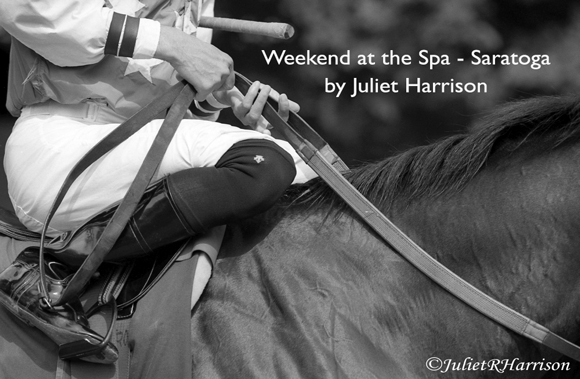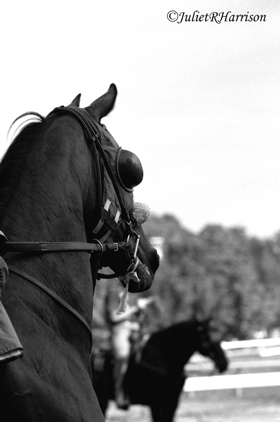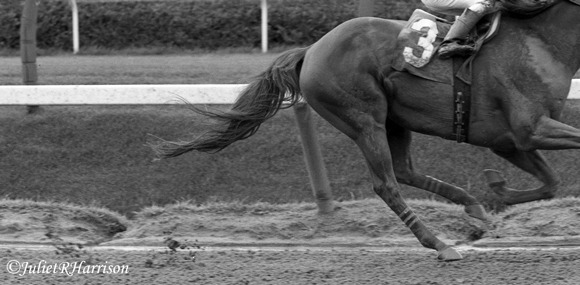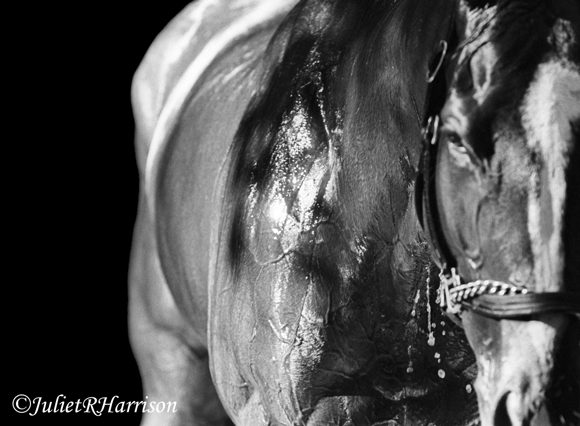Weekend at the Spa - Saratoga
by Juliet Harrison

I have been going to the race track in Saratoga Springs every summer for the past 8 years.
I go because I am an equine artist. By medium, a photographer. I do not shoot for media outlets. The work that I do is intended for framing and hanging on the wall. I go to meet up with a group of fellow equine artists, the rest of them, painters. We go to immerse ourselves in the pageantry of the track, and to gather imagery to later use in the creation of artwork. But mostly, we go once a year to spend a long weekend together surrounded by what we mutually love and are inspired by – HORSES, artwork, good company, and ice cream.
We rent the same development style ranch house in a nearby town where we gather every year, from our far flung locations. It comes equipped with all that we need - bedrooms, kitchen, a resident house cat, and most importantly, Wifi. License plates on the driveway attest to distances travelled. As usual, this year Kimberly Kelly Santini arrived from Michigan. Former teenage pony girl from the days when women were barely tolerated on the backside, Sharon Simons Passmore drove up from Tennessee. Alecia Barry Underhill came in from Connecticut for the second year, and I am the closest from just a few hours South in the Mid-Hudson Valley. In the past we have also had regulars, Linda Shantz from Ontario, Canada and Jenifer Trottier from New Hampshire. All of whom, I am happy to say, are represented by my Equis Art Gallery. Sometimes it has been just two of us, other years as much as six. We have learned to accommodate whoever comes with places to sleep and room in the refrigerator.
 We leave early in the morning to get to the track for workouts, but we don’t always get there in time to see the best horses or to capture the morning fog. For some of us it is our only vacation, so getting up at the crack of dawn is not always possible. Every late morning we take a break for brunch and pastries at Mrs. London’s on Broadway. This is a ritual that is as important as any other we follow while we are there. No matter what has gone on before, is on tap for the afternoon that day, or if we’ve been rained on, and are muddy or sweaty - we go to Mrs. London’s. Rituals are important in horse racing after all. Afternoons are spent either at the track for the day’s races or in town for gallery hopping and shopping. We can get as much from being in a town filled with the inspiration of the work of other equine artists as from the track itself. The National Museum of Racing and Hall of Fame is a favorite spot for soaking in the work of the masters of sporting art. As stated earlier, I have been traveling up for this weekend for many years now, but as I am so close, I do sometimes head up by myself at other times in the season. But when I do, it feels like a whole different Saratoga from the weekend I spend with friends.
We leave early in the morning to get to the track for workouts, but we don’t always get there in time to see the best horses or to capture the morning fog. For some of us it is our only vacation, so getting up at the crack of dawn is not always possible. Every late morning we take a break for brunch and pastries at Mrs. London’s on Broadway. This is a ritual that is as important as any other we follow while we are there. No matter what has gone on before, is on tap for the afternoon that day, or if we’ve been rained on, and are muddy or sweaty - we go to Mrs. London’s. Rituals are important in horse racing after all. Afternoons are spent either at the track for the day’s races or in town for gallery hopping and shopping. We can get as much from being in a town filled with the inspiration of the work of other equine artists as from the track itself. The National Museum of Racing and Hall of Fame is a favorite spot for soaking in the work of the masters of sporting art. As stated earlier, I have been traveling up for this weekend for many years now, but as I am so close, I do sometimes head up by myself at other times in the season. But when I do, it feels like a whole different Saratoga from the weekend I spend with friends.
As a black and white film photographer, shooting at the track is a huge challenge for me. Finding a way to work in a place where access is limited and the pageantry of color seems almost integral to the scene, has been my personal goal. For the friends that I accompany, it is a bit different. They shoot reference images for paintings that they will create, sometimes years later. I wasted a lot of film in those early years. I don’t photograph people, so the crowds of visitors have no appeal for me. Standing at the rail photographing horses running past at a distance, made for some boring early imagery. As exciting as it felt to be there, it was nearly impossible to convey that sentiment in my shots for those first few years and I wanted to convey my excitement, the thrill of being there, and of witnessing these stunning equine athletes. Getting access to the not so public areas of the Saratoga track can be difficult for equine artists. While, on the surface, I understand the liability issue, on the other hand, I wish that such access could be determined on a case-by-case basis for those that request it. Each year we’ve scrambled to get passes to the paddock and backstretch, and up until last year, that meant sometimes, thanks to connections, we had total access, while other years, we had none at all. Last year, we were welcomed by an assistant trainer who has become a close friend. Her invitation to spend time with her barn has certainly given me the opportunity to transform my work into images that are even more meaningful and I hope, significant.
I was not very knowledgeable about horse racing when I first went to Saratoga 8 years ago. I credit the very patient Linda Shantz for teaching me just about everything that I know. As someone immersed in the Thoroughbred world, from the track end, foaling farm, and thoroughbred art end – she has been my perfect mentor, and thankfully, willing to answer my every question. It was just the both of us for that first year that I came up for the day. With all of the experience and knowledge that she and Sharon Passmore have, you would think that we bet, but we never do. Never. I figured that if they did not, with all of their years of accumulated knowledge, there was no reason for me to waste my money. So, I admit that I still don’t know anything about odds or handicapping. Perhaps I will find someone to take on the task of teaching me that in the future. What I have learned and what I want to convey with my images, is that, what happens on the track, in that tiny window of time that is the actual race, is really all about years of early mornings and late days. It is about the huge number of tasks that get done ‘behind the scenes’ each and every day. It may seem that racing is about galloping fast. But galloping fast is a tiny fraction of a racehorse’s day, if at all. Most of their day is spent in the stall resting, eating, being bathed, and more than anything else, walking. They walk for exercise; they walk to the track for workouts; they walk after they exercise to loosen up and cool off; they walk to the paddock and back for training; they walk to the paddock for saddling; they walk to the track from the paddock, and they walk back to the barn after they race, where they walk to cool off again. Ask the grooms, horse racing is about walking, not running. A young racehorse is learning to walk quietly and stand still at the same time that s/he is learning to run fast when asked.

Similar to what goes on backstage in a theater, what is seen by the public seems so seamlessly coordinated; however, there is a choreography to the race that happens in the blending of all that is done by the ‘players’ behind the scenes. It is hard to describe in words, at least for me, the powerful peaceful quality that I feel on the backside dancing right alongside the reined in excitement and intensity that happens there. The backside is where I tend to find my inspiration and imagery. In the intimate moments. In the details of muscle and bone, leather and metal, water, and dust. I’ve found that the moments that most people don’t pay any attention to, are the ones that really guide the show. It began for me, in the paddock, with images of the jockey’s hands ‘getting tied on’ after they mount. This gesture personifies the point of communication between the horse and the rider. Other than jockey’s voice and balance, perched as they are on the tiny saddle, this connection is the only real method of communication that the jockey has with the horse. This observation was my point of entry to photographing at the track in a way that was my voice, and I have pursued these discoveries each year since. This is what artists do. We freeze time and point the viewer towards something that we want them to notice. Large or small.
At the end of the day, for the days that we are there, we go back to the house, (our house for that weekend). We take our shoes off of our tired feet, set up our laptops, and while those with digital cameras upload their shots for the day, the rest of us check emails and prepare dinner. We share our meals with wine and laughter, enjoy assorted ice creams for dessert, and talk about our amazing experiences for that day, while planning for the next. We wait all year for this trip, and can never believe how short it is when it is over. Most of us only see each other this one weekend a year. We leave on Sunday filled with the kind of warmth and imagery that can only happen in “our” magical Saratoga.
When my friends and I go to the track in Saratoga, we try to see it with eyes that are somewhat different from most others who go there. Every year, we get caught up in the excitement of motion and the quiet of the stillness. We absorb everything that we can, through all that we see, and distill it into the imagery of artwork.

Thanks to our years of Saratoga weekends, Kim Santini is now a featured artist at the Spa Fine Art Gallery in Saratoga, and was commissioned to create the painting from which the 2015 Kentucky Derby poster was derived. I have two books that were published from images taken at the race course in Saratoga. We have all gained an immeasurable amount of knowledge and inspiration, and made new friends from within the racing community. Our closeness to each other has grown beyond expectation: Born on the internet and nurtured in Saratoga once a year – the result is breathtaking equine artwork and lifelong friendship.


